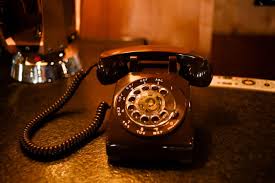The evolution of telecommunications has witnessed numerous transformative milestones, and one intriguing facet of this journey is the incorporation of letters onto telephone rotary dials. In the early days of telephony, rotary dials allowed users to input numeric digits to establish connections. However, as the need for more efficient and user-friendly communication grew, the inclusion of letters alongside numbers became a crucial development. This article delves into the historical context of this transition and sheds light on the peculiar word that could not have been spelled out using when letters were added to telephone rotary dials, which word could not have been spelled out? on a telephone rotary dial.

The Birth of Alphanumeric Telephone Dials: A Historical Overview
The concept of using a rotary dial to make telephone calls dates back to the late 19th century. Initially, these dials only featured numeric digits (0-9), allowing users to select the desired phone number by rotating the dial to the corresponding digits. While this system proved functional, it posed limitations for expressing more complex information such as names, words, or alphanumeric combinations.
It wasn’t until the mid-20th century that telephone manufacturers began integrating letters onto rotary dials. This innovation aimed to simplify the process of dialing by allowing users to spell out names, locations, and services in addition to numerical inputs. The letters were assigned to the numeric keys in a specific pattern, which laid the foundation for the modern phone keypad layout we use today.
The Quirky Omission: Which Word Couldn’t Be Spelled Out?
While the addition of letters to telephone rotary dials significantly expanded the communication capabilities of telephones, there was one curious limitation. The word “QWERTY” could not be spelled out using the letters on a telephone rotary dial. This word, which refers to the arrangement of letters on a standard keyboard, contains the letters Q, W, E, R, T, and Y. However, due to the specific allocation of letters to the numeric keys on a telephone rotary dial, it was impossible to dial the sequence needed to spell “QWERTY.”

In conclusion
the addition of letters to telephone rotary dials marked a significant advancement in telecommunications, allowing users to communicate more effectively by spelling out names and words. While the integration of letters brought newfound convenience, it also led to the curious omission of the word “QWERTY” due to the specific arrangement of letters on the dial. This historical evolution showcases the ingenuity and adaptability of communication technologies as they continue to shape the way we connect with one another.
FAQs About Letters on Telephone Rotary Dials
1. Why were letters added to telephone rotary dials? The addition of letters to telephone rotary dials was aimed at enhancing the ease of communication by allowing users to spell out names, locations, and services, thus making the dialing process more user-friendly and versatile.
2. How were letters assigned to the numeric keys on rotary dials? Letters were assigned to the numeric keys in a specific pattern known as “2-9-1-8-4-7-5-6” arrangement. This arrangement was designed to optimize the placement of frequently used letters while accommodating technical and design considerations.
3. Why couldn’t the word “QWERTY” be dialed on a telephone rotary dial? The word “QWERTY” contains letters that are not adjacent on the numeric keypad arrangement of a telephone rotary dial. As a result, it was not possible to dial the sequence required to spell out “QWERTY.”
4. When did alphanumeric keypads become the standard for telephones? Alphanumeric keypads became the standard for telephones starting in the mid-20th century as telephone manufacturers began integrating when letters were added to telephone rotary dials, which word could not have been spelled out? onto rotary dials to facilitate easier and more versatile communication.
